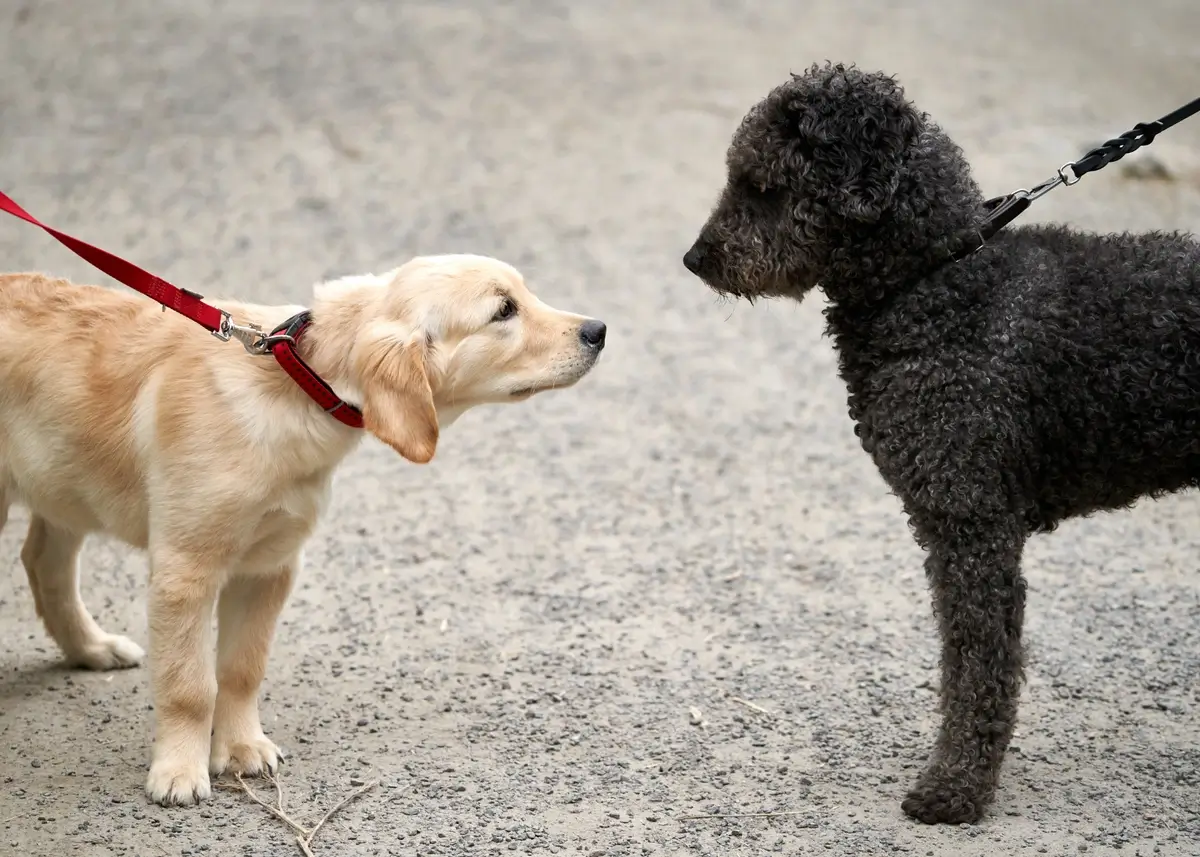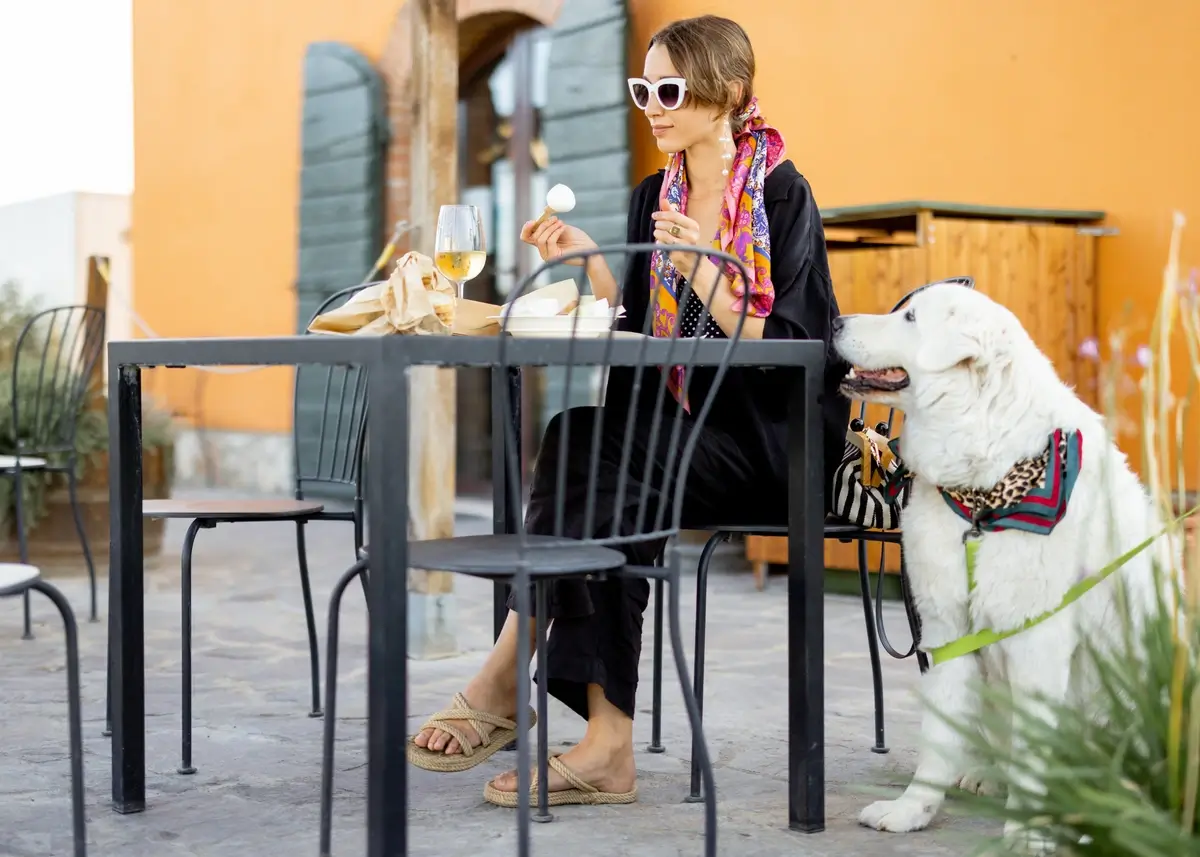It’s a new year, and most of us have made resolutions about improving our health. How convenient is it that January is Walk Your Dog Month? Now is the perfect time for you to get in shape by doing one simple thing – walking your dog.
Celebrate National Walk Your Dog month with a new dog walking routine. Get up off the couch, put on your coat, & prepare to have a fantastic bonding time benefiting humans and canines alike with our 18 tips for a great dog walking experience.
The Human Benefits of Walking Your Dog
Walking your dog is an essential part of any dog's life and should not be overlooked. Not only does it provide physical and mental exercises for your dog, but it’s also a great way to unplug, spend time outdoors, and bond with them. From improved blood pressure and bone density to better sleep patterns, dog walking isn't just about being kind to our furry friends but is also about taking care of ourselves, too.
How much exercise should an adult get per week?
If you're wondering how much exercise an adult needs per week, various sources say adults should get a total of at least 150 minutes of moderate intensity exercise a week like brisk walking, or at least 75 minutes of vigorous activity like hiking or running. You can meet this recommendation with about a 22-minute walk (or 2 11-minute walks in the morning and evening) with your dog every day.
A body in motion stays in motion
When you take those first steps of the walk, you’re more likely to stay in motion throughout the day and in your life thanks to Newton’s First Law of Motion. Going on a dog walk helps get you in the right frame of mind to keep up your level of activity – and even add more minutes to your day to go on to more rigorous physical activities to reap those health benefits.
In what ways does walking provide crucial physical health benefits?
We could write an entire book series on the benefits of physical activity, but we’ll just give you an overview. Dog walkers tend to have lower risks of high blood pressure, obesity, diabetes, joint issues, muscular atrophy, and a whole host of other medical issues. You can even extend your life and keep your brain healthy as well if you are active in your golden years.
How does walking improve your mental health?
On top of all the physical benefits, walking a dog can also improve your mental health by spending quality time bonding and experiencing the unconditional love of a dog. Walking your dog daily creates a sense of purpose and accomplishment and encourages you to be social while exploring your community.
The Benefits of Walking For Dogs
Your dog experiences so many benefits from going on regular walks. Not only do they get the exercise they need, but they also get to explore new areas and take in all sorts of sights and smells which can help keep them active and engaged. Here are just some of the ways your dog’s life is enhanced by a walking routine.
Establishes a routine for the entire household
Both humans and canines benefit greatly from creating and sticking to a routine. It’s easy to cancel a walk for a variety of reasons, some legitimate and others not so much. Bad weather, behavioral problems, laziness, tiredness, small children at home, work responsibilities, illness, and failure to plan are all reasons why humans may skip a walk.
Dogs are creatures of habit and appreciate knowing what to expect. It gives them a rhythm to their day that helps them regulate their food intake and bathroom habits and allows for a steady sleep schedule. Adding in a daily dog walk or two a day can increase your dog’s security and confidence as a member of your family.
Improves behavior
Dog walking helps burn off all the energy they have so that when they’re back inside, you won’t have to worry about them chewing up the furniture or tearing through the house! A lively walk can be especially helpful for high-energy breeds or puppies.
When a dog is both physically and mentally stimulated, they are less likely to have puppy separation anxiety and engage in destructive behaviors such as excessive barking, aggression, property destruction, chewing, and digging.
Teaches regular bathroom habits
When you use a walk as an opportunity for your dog to relieve themselves, they’ll quickly adapt to potty cues and commands you teach them. Allow your puppy to sniff around to find the perfect spot to do their business. Rushing them through the process can send confusing signals to your puppy and even cause health complications, such as constipation or urinary tract infections.
Prevents obesity and other health problems
Dog owners grossly underestimate if their dog is overweight or obese. In a 2021 survey, only 39% of dog owners consider their dog overweight or having obesity. However, numerous reports indicate that over 50% of dogs in America are overweight or obese which ends up being over 50 million dogs.
Walking your dog regularly can not only help prevent canine obesity, but it can also improve cardiovascular, renal, and joint health and lessen the chance of osteoarthritis, not to mention various other health conditions.
18 Dog Walking Tips For the Best Experience
1. Know your dog’s needs
Dogs depend on us for their basic needs. Can you confidently say you are truly meeting their basic need for exercise? A review of several dog walking studies show while 78% of people said that dogs deserved to be walked twice a day, nearly 40% of people do not walk their dogs regularly.
You need to determine the right amount of exercise for your dog’s breed, their activity level, and health status. Commit to giving them the amount of exercise they deserve. This may mean introspectively assessing your current habits and making some major changes.
Many people assume only big dogs need to go on walks and neglect to take their little dogs on walks. They may also assume that walks are too much for older or overweight dogs, but the key is to know your dog’s needs. Rather than assume things about your dog, create a sufficient walking plan that meets the needs of your dog to stay healthy and get started!
2. Have proper identification
Before you leave the house, check to see if your dog has proper identification tags with as much information about yourself as would be the best bet to return your dog to you if he or she gets loose.
If your dog is not microchipped, make that appointment right now! If your dog is, make sure your information is updated and accurate. Dogs can dart off at any time, even if we are confident in our dog’s regular behavior. It’s best to proactively help the chances of the person that finds your dog be able to return him or her with the least amount of hassle.
3. Do a health check
Before you go walking, do a spot check to see if their paws are in good shape, their gait looks normal, or any lingering health issues that may prevent them from walking their best. It’s also helpful to do a baseline check to tell later if there is anything amiss, like a wobbly gait or a limp.
4. Don’t be just a fairweather friend
Rain or shine, our dogs will still have to do their business. They may have too much energy that you simply cannot skip your daily walk no matter what it looks and feels like on the other side of your living room window.
Don’t let a day of bad weather deter you from going exploring. Dogs can have a blast in the rain and snow! Some dog breeds have double coats with a thick, weatherproof outer layer and a soft, lofty inner layer to keep them insulated. Other dogs that don’t have much protection built into their natural coats can wear cute rain slickers, sweaters, and coats. Other breeds don’t tolerate the heat well, so stick with morning and evening walks when the hottest part of the day has cooled off.
Be sure to check your puppy’s paws after your walk in extreme weather. Check for any cuts or frostbite in cold weather, and test the heat of the pavement so their paws don’t blister.
5. Be prepared
Whether you go on a mile-long stroll or a 4-mile hike, it’s always important to be prepared. Know your route and use a map with well-marked streets and trails. Bring a charged cell phone with an emergency vet’s number saved in your contacts in case of a sudden unfortunate event.
Take a snack and enough water for both of you and pack a small, collapsible bowl. Wear proper shoes and clothing for the walk to avoid being uncomfortable. And don’t forget your bad-weather gear! You wouldn’t want to be caught unprepared in a surprise downpour.
6. Wear proper footwear
The best type of shoes to walk your dog in are the ones that are the most comfortable for you and that hold up in walking conditions. Even if you’re in a hurry, take the time to put on your walking shoes instead of risking painful blisters from going out anyway with improper footwear. Be sure your shoes can also withstand bad weather and keep your feet warm and dry when you have to splash through muddy puddles.
7. Safety first
In addition to being prepared, you’ll want to make sure you have safety at the top of your walking priorities. If you walk early in the morning or evening during the dark, use a reflective leash or vest for both you and your dog, and bring along a flashlight to help see the way and pick up dog waste.
8. Be present
Part of being safe is being present. When your mind is elsewhere, you can miss important signals that catch you unaware. Pay attention to your surroundings to check on any approaching people or animals. Stay in tune with reading your dog’s body language – they may detect that squirrel across the muddy creek or smell another approaching dog before you even notice.
Common distractions you may experience include being on your phone too much, getting lost in your thoughts or in a conversation, and listening to loud music without being cognizant of what’s going on around you.
9. Find a walking buddy
Whether you go with an old friend, a new neighbor, or a local club, find someone to walk with you. Bring along the dog friends, too, if your pups are compatible. Being in the company of a walking buddy helps you build a routine, get some exercise, and have accountability, and your dog will appreciate the new interactions as well.
10. Switch up routines
While dogs thrive on routines, that doesn’t mean they don’t want to see a change of scenery every now and then. Walking another route provides a whole set of novel smells, sights, and sounds, fresh terrain to explore, and new dogs to sniff out.
Alternate the among of time you walk as well. You may do some shorter walks during the week and opt for a longer hike on the weekends to give some variety.
11. Stop and smell the flowers
Walks give your dog a sense of exploration and identity as they sniff out unknown smells and explore new territory. Dogs interact with the world around them primarily through their sense of smell. In fact, humans “only” have 6 million scent receptors compared to the hundreds of millions of scent receptors dogs have! They also utilize 40 times more brain volume in decoding smells. Owners must understand and honor the overwhelming need for a dog to sniff its surroundings.
As such, dogs find out a lot about their environment through their noses. They can “meet” dogs by sniffing the areas where they’ve relieved themselves, using their urine as a signal to other dogs containing information like if they’re male or female, what they’ve eaten, how old they are, and if they’re ill or well. Taking your dog on a scent walk and letting them sniff and snoot around is like letting your dog scroll through their Dog-stagram feed.
12. Train your dog
You’ll need to train your dog to walk on a leash because it’s not a skill they are born knowing. Dogs must have proper manners on a leash because lunging, jumping, and excessive barking or growling are not cute.
Start with short dog training sessions with your puppy to get them used to the leash and teach basic commands. Some great dog commands to work with using a leash are Sit, Heel, Go Potty, Come, Down, Leave it, and Drop it.
Don’t forget the treats! Bring along a small pouch of delicious treats to speed up positive reinforcement for those training sessions.
13. Keep your dog leashed unless otherwise specified
You may trust your dog, but even the best-behaved unleashed dog can cause a world of trouble. They can get into things they shouldn’t, like a polluted stream, animal feces, or garbage. Other dogs can be reactive toward dogs not on leashes.
Even people who are dog lovers can be caught off guard when an unfamiliar dog comes up to them. People who have had bad past experiences with dogs can feel threatened. Children may be terrified. Calling out “Oh, he’s harmless!” is not an acceptable way to behave with your dog out in public (or even with visitors in your home).
If you do take the leash off your dog, make sure they are in a designated, secured area and have excellent recall skills. It can also be a great place to work on other training skills in addition to coming when called.
14. Choose a leash that’s right for you
The leash you use makes a huge difference in your dog’s walking behavior and training experience. In fact, you may go through a few before you find the best type of leash for your dog. Choosing a simple leather or webbed nylon leash is a great starter tool to use for training. Smaller dogs may enjoy a retractable leash. Keep trying until you find the one that works for you.
15. Select an effective collar or harness
In addition to carefully choosing a leash, selecting a collar or harness that provides structure, security, and comfort for you and your dog is important! While your dog is learning how to walk on a leash, your dog will probably want to pull on the leash and drag you along or jump up.
Until your dog learns to heel with ease, the right collar and harness can prevent tugging on the leash in the first place and guide your dog to make the right choices. If you have a larger, strong breed, a harness may even be necessary to effectively control your dog when they want to be naughty and not follow commands.
16. Clean up after your dog
As a responsible pet owner, never, ever leave your dog’s waste on the ground for someone else to deal with. It’s unsanitary and causes public health problems. Several dangerous and even fatal diseases can be found in contaminated waste, such as giardia and other parasites that cause common illnesses in puppies.
Don’t get caught without a bag and leave it there. Come back with a bag, pick it up, and dispose of the waste properly!
17. Take responsibility for your dog’s actions
We would like to think our dog is always a perfect angel, but truth be told, you can’t predict how your dog will act with 100% accuracy. In addition to always cleaning up after your dog, always take responsibility for any negative actions your dog takes. It’s your responsibility to apologize for and fix whatever situation your dog has placed you in if your dog is at fault. Document or summarize any events your dog is involved in just in case you need to access the information later.
18. End the walk with a fun activity
Do something fun at the end of the walk to celebrate your puppy and keep things interesting. Dog bakeries offer a huge range of treats and can serve as a hub of information for dog owners. A trip to the store to pick out a new puppy toy, a visit with a friend, and enjoying a doggy beverage at a brewery are all interesting and social ways to end your walk with a bang.
Enjoy Walking a Pawrade Puppy
Now that you know all the benefits of walking for humans and our 4-legged friends, you need a puppy to walk! That’s where Pawrade comes in. We work with reputable, trustworthy breeders to offer healthy & happy puppies for sale that will make fantastic walking buddies.







